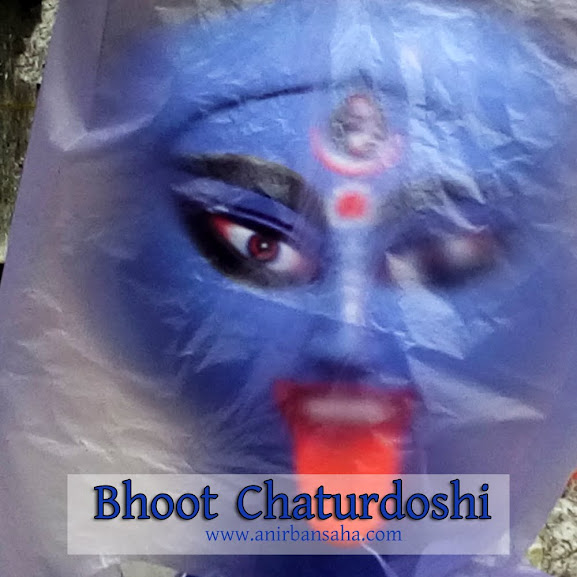A few days back almost all of our social media feeds were full with pictures of pumpkins. And they were meant to be scary! Being from the land of “Kumropotash” (Translation: Not found.), I can imagine pumpkins to be the vegetable symbolizing the lethargic spirit, but not really scary.
I looked around the internet a bit and came to know that those pictures of pumpkins were actually put since many people in America and other western nations were celebrating Halloween. Halloween followed by “All souls day” celebrates everything spooky and uncanny in the Occidental school of thought.
Closer home, the spirits and the call of the unknown gets scarier as the call of the “Amavasya” (the new moon night) approaches. “Bhoot Choturdoshi” is actually our answer for the lame and innocent pumpkin which tastes much better in a well baked pie.

Kali Puja marks the end of the Krishna Paksha | Shot with mobile camera, Lava Pixel V2.
We have always heard of Pitri Paksha (Pitru Paksha) and Devi Paksha. After the end of Pitri Paksha, the Devi Paksha starts with Mahalaya where we pay homage to our forefathers. It continues till Lakshmi Puja (worship of the Hindu Goddess of wealth, during a full moon night). Then begins Krishna Paksha (the phase where the moon diminishes) which ends with Kali Puja. We complete the cycle by paying homage to the departed souls (ancestors) during Bhoot Chaturdoshi, which generally falls on the day before Kali Puja.
There are different perspectives about Bhoot Chaturdoshi. One says that the custom of lighting fourteen lamps marks respect to the fourteen generations of our ancestors. While another tells the story of Maa Chamunda (another form of Maa Kali) and fourteen other horrific spirits.

Ugly ghosts as decoration for Kali Puja | Photographs shot by Lava Pixel V2
According to this school of belief, Maa Chamunda along with fourteen other ghostly forms scared everyone around. The Dakini and Jogini, that we were so scared of during our childhood could be two of them! So fourteen lights placed at fourteen of the darkest corners of our homes to ward off evil spirits.
Mythologies apart, Bengali customs are more about the food. This too is no exception. Bengalis all across the globe, frantically look for their grandmother’s “Choddo Shaak (fourteen green leaves)” recipes. This custom believes no evil spirit could reside in your body if you eat them (with rice).
A Bengali home is often characterized by it’s love for “Jhorna Ghee” and “Benimadhob Seal’er Ponjika”. While there are several theories about which leafy vegetables you should eat to ward evil spirits off, Benimadhob babu comes to our rescue, every single year. If you want to know the list, please leave a comment asking for it.
Quite contrary to the previous Sujola Sufola Bongodesh, most of the green vegetables aren’t available today. People look for replacements, definitely when they live outside India.
The water which is used to wash the vegetables, is sprinkled inside the home in different corners to ward off evil spirits. Children are often asked to not venture out of their homes, after sunset during this time.

Some more spooky ghosts. | Photographs taken by Lava Pixel V2
Was there a belief that evil spirits roam free during the darkest of nights (new moon night) that follows the night next? May be. Many from different parts of India who indulge in the study of spirits perform various rites and rituals, often called “Naraka Chaturdashi” and “Yama Chaturdashi”. These events too are done to ward off evil spirits from the household.
Interestingly “Dhanteras” is celebrated a day before “Bhoot Chaturdoshi”, on the thirteenth day of Krishna Paksha. Now a business opportunity for gold retailers across India, this is an occasion where Kuber (deity related to wealth) is worshipped. From Dhanteras to Diwali, people in the north celebrate wealth, Goddess Lakshmi and God Ganesha.
A certain section of Bengalis (umm, Ghoti to be particular), Goddess Lakshmi is worshipped during Kali Puja after a quick cleansing of anything unholy, evil and unlucky, “Olokkhi Bidaye!”. Whether there is a relation between this cleansing and safeguarding your home against evil spirits, is somewhere lost in transition.
The interesting connect between the fear of evil spirits and the worshipping of the Divine for wealth and prosperity during the same period of time, in different parts of the country, by people with similar religious believes, is something worth pondering upon. Evidently Bhoot Chaturdoshi is a living example of how living customs and traditions change locally and how local customs fuse to make something unique every time.
What more amusing is how Bengalis introduce delicious recipes to every single celebration! The innocent looking pumpkins do not stand a chance in front of our deliciously cooked “Choddo Shaak” and the fear of the unknown. So what if you could not manage to get all the fourteen readily available? Customization always saves the day and it is the spirit that always matters.
On that note, have a spooky and scary “Bhoot Choturdoshi” guys!

Spooky Bhoot Chaturdoshi! Photographs taken by Lava Pixel V2.
Guest post by Paushali De Roy with inputs from Sharmistha Bag.
Paushali De Roy is a lawyer by profession. Calcutta, food, travel and ‘every thing Bengali’ are things which interests her immensely. Paushali loves to voice her thoughts on her blog and intends to publish her book someday, soon.

Excellent read! Yes very informative too.
Thank you If possible, please do share
If possible, please do share 
You can also check http://www.rudraksha-ratna.com/ and http://www.chakrayog.com/ for more information
Beautifully scripted and a very interesting read with splatters of humour.
My family is purely “ghoti” from both sides but there is a difference in customs, my mother’s side has all the “Bhoot Chaturdashi” and “Kali Puja” rituals to the word, and my father’s side has “Dipanwita Lakshmi Puja” and “Alokkhi Bidaye” rituals during Diwali…so we celebrate both at this time of the year. I think the best thing about our festivals is the acculturation taking place between various factions of the Bengali community. This diversifies and adds more colour to our festivities.
Thank you Taniya Its always amazing to know about such wonderful customs and traditions.
Its always amazing to know about such wonderful customs and traditions.
Nice Information on Bhoot Chatiradshi